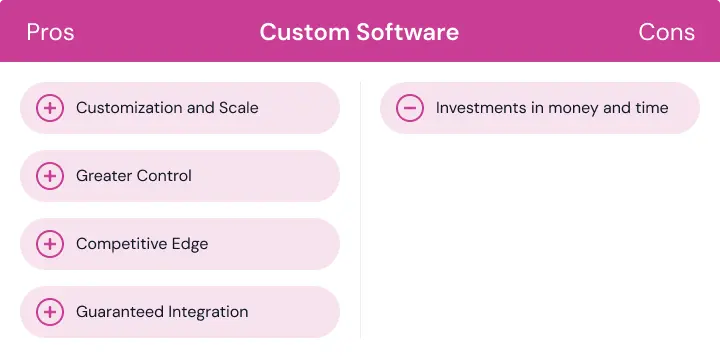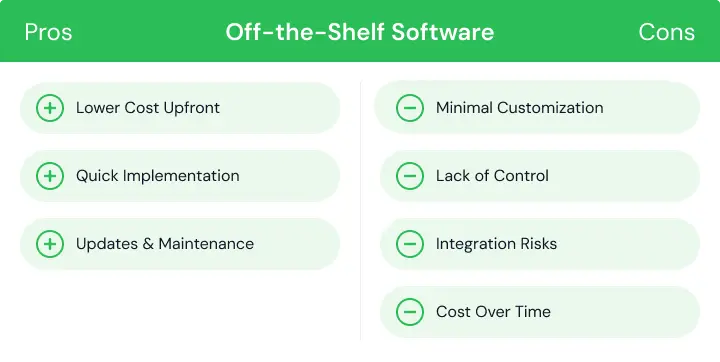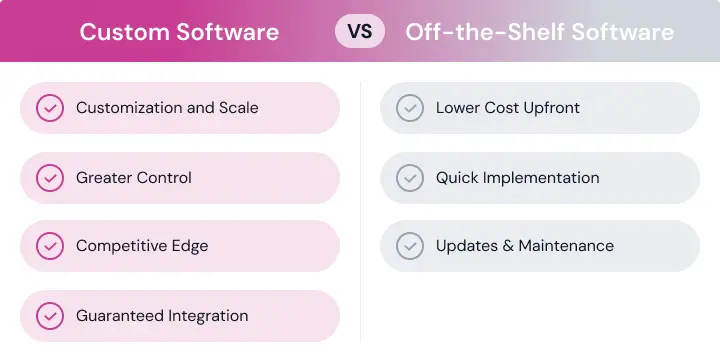Introduction
In the digital age, businesses rely on software to outperform the competition. There is a software-as-a-service (SaaS) product for every business process you can imagine.
There are dozens of options to choose from: CRMs, ERPs, project management, billing, accounting. However, choosing the right solution (or solutions) is easier said than done, and usually, after trying several SaaS vendors, managers come to the conclusion that they might prefer to undertake some custom software development instead of signing another multi-year contract for a licensed product.
Unlike out of the box SaaS solutions, custom software is tailored with the organization's business processes, workflows, strategy and human capital in mind.
In this blog post, we'll explore the pros and cons of both custom software and commercial off-the-shelf software and when to choose one or another, guiding you to the right decision for your organization.
Custom software
So, how do you know if custom software is the right choice for your business? Let's take a look at the pros and cons.

Pros of custom software
Customization and scale
One of the biggest pros of building your own custom software solution is that it will be purpose built to operate in exactly the ways you need it to. Off-the-shelf software tends to be limited in customization capabilities, but your custom product will be tailored to your unique business model and challenges.
This control also means you have the ability to add any new features at any time, ensuring your platform grows with your business, supporting you instead of slowing you down.
Greater control
As the sole owner of the solution, you will have full control over user options, security measures, and system updates. When you need a change, you have the power to make that change. You also have the option to market the product itself, turning it into a new revenue stream by offering a ‘white label’ version to other businesses.
Competitive edge
A custom software solution gives its user a competitive advantage in the form of the most efficient, connected, and scalable technology available.
The limitations of off-the-shelf software can make it hard for businesses to meet their more complex needs, but a tailored software solution will help you get ahead of the game, differentiating your business from others in the crowded marketplace.
Guaranteed integration
Many companies rely on multiple technology platforms and systems to support every department's operations. But when those disparate platforms don't integrate well with one another, this ecosystem can slow down the business more than helping it. Building your own solution means you can ensure seamless integration with any existing software, tools and processes already in use.
Cons of custom software
There's a lot to love about custom software, but it's not for everybody. The two biggest drawbacks are the upfront investments in time and money.
Like anything that is made to order, a custom solution will require more time and money upfront than an off-the-shelf product. For many companies, the cost alone makes off-the-shelf a more feasible option.
However, it's important to remember that off-the-shelf solutions may not always be the most economical route in the long run, due to opportunity costs of ill-fitting features and processes or rising license and subscription rates.
The other upfront requirement is time. From the painstaking planning to the coding and testing, custom software development is certainly a longer process than implementing an off-the-shelf solution.
Is custom software for you?
Consider building your own software solution if your software needs are complex or unique (something an off-the-shelf solution can't meet), if you have the time and money available to invest, and if you're interested in owning (and maybe even profiting off of) your software solution.
Cost of custom software
We highlighted the upfront cost as a potential drawback. But how much does a custom software development cost, exactly? Well, it depends.
The cost of a custom software application can vary from a few thousand to millions of dollars, because no two custom software applications are identical. Think of it like building a house. A 1-bedroom cottage and a 15-bedroom mansion are both houses, but the details and the costs will vary dramatically.
The software's size and complexity, along with the creative design involved, the integrations required, the complexity of data migration, and other elements, will all factor into the cost.
So, as you interview potential vendors, pay careful attention to how they're scoping out the project by using our tips for validating software estimates. Unfortunately, a quote that seems too good to be true probably is.
Examples of custom software: Syberry's DaVinci platform
At Syberry, we're a little biased toward custom software development, but we had to make the same ‘build or buy’ choice that so many of our clients are making.
A few years ago, we were a small firm with a handful of employees, and things were simple. We kept records mostly in spreadsheets, with the help form well-known cloud solutions as CRM and project management tools.
But even in the beginning, we knew we would have to start building a solution to support our growth and retain and improve the quality of our services before we could become a bigger organization. As we grew rapidly, scaling up to a couple hundred employees and acquiring big customers, we realized it was time to get more sophisticated.
At first, we used a network of third-party systems, including Salesforce. But we quickly realized that we wanted to optimize our software to fit our processes (and not the other way around) and that our integration needs were becoming far too complex. We needed a clean, custom ERP that could power our whole business.
We called our internal system DaVinci as a tribute to the famous Italian Renaissance-era inventor and engineer. It was designed from the ground up with the end goals of replicating all the most useful features of the systems that we used, removing all known redundancies, matching our current business processes, and considering future needs arising from further growth. The cornerstones of the system were that it must be user-friendly and that it must retain process knowledge in a single, accessible location.
It took plenty of time and resources to get our custom ERP up and running, but the journey has been well worth it. We increased our efficiency by replacing the messy workflows with a clear, crisp system that management has full control over, and we also dramatically improved visibility into everything happening in the company at any moment in time.
Off-the-shelf software
Off-the-shelf software is a ready-made, typically SaaS, solution created by a third-party vendor and designed to support a large number and variety of operations in a specific business domain.
Off-the-shelf software is generally sufficient to support simple, straightforward business goals. It may require some configuration, but it is generally fairly ‘plug and play’ ready, with lower upfront costs but ongoing subscription and licensing fees.

Pros of off-the-shelf software
Lower cost upfront
If you are new in business or cash is scarce in your organization, pre-built software may be a compelling option since it is typically cheaper to buy and implement.
Quick implementation
Off-the-shelf solutions should be ready to use as soon as you pay and implement them, with minimal configuration required. If an off-the-shelf solution meets most of your needs, it may be smartest to use that, rather than paying the price in development fees and missed opportunities to streamline operations, improve the client experience, and grow revenue.
Competitive edge
A custom software solution gives its user a competitive advantage in the form of the most efficient, connected, and scalable technology available.
While the limitations of off-the-shelf software can make it hard for businesses to meet their more complex needs, a perfectly tailored software solution will help you get ahead of the game, differentiating your business from others in the crowded marketplace.
Updates and maintenance
A SaaS solution's vendor will take on the responsibilities of maintenance with minimal investment from your team. And, they'll be on top of updates as well. These providers will want to stay competitive, so you can be confident they'll be iterating frequently to keep their solutions up to date with common industry standards.
Cons of off-the-shelf software
Minimal customization
While many existing SaaS solutions offer some customization, they are built to serve masses. This means you may find yourself having to tailor your processes and workflows to the software, instead of the other way around.
Lack of control
While it can be an advantage for the vendor to control updates, it also means you're at the mercy of their product roadmap and not your own. While buyers and users can put in requests for new features, repairs or upgrades, all key decisions are out of your hands.
Integration risks
Pre-built software may not be able to integrate smoothly with other platforms, devices or products you are using (or may want to use in the future). When this is the case, you may be implementing more logjams and obstacles than efficiencies into your ecosystem.
Cost over time
Although ready-made software may be cheaper to buy initially, its long-term costs may outweigh the upfront investment required for custom solutions.
Is off-the-shelf software for you?
Consider buying off-the-shelf instead of investing in custom solutions if your software needs are standard and straightforward, your cash for upfront expenses is limited, and/or you need a basic solution quickly.
Cost of off-the-shelf software
Off-the-shelf software is generally sold on a software-as-a-subscription model. This means your subscriptions and licenses will require regular renewal fees. Additionally, pricing is often determined on a per-user basis, so if your company grows significantly, you will have to add additional licenses to pay for the additional users, too.
Finally, every customization or add-on you may want will cost money as well, leading to inflated budgets and extra spend.
Examples of off-the-shelf software
Off-the-shelf software is prevalent across a variety of industries and business needs, and there are plenty of great options on the market for everything from customer relationship management (Hubspot, Salesforce) to accounting (Quicken) to online retail (Shopify).
Every industry has off-the-shelf software solutions available to them as well. So, if you suspect your software needs are fairly common for your industry or your department, it's worth researching what might already be available to you and whether it's a good fit for your existing processes and workflows.
Differences between custom software and off-the-shelf software

As you saw in the pros and cons, there are several key differences in custom or proprietary versus off-the-shelf software. These are the most important:
Cost
Most of your costs with custom software are upfront, while your off-the-shelf software costs (which may be greater in the long run) are spread out over time.
Time
Off-the-shelf software can be implemented very quickly, while custom software (when done right) will take a while to ramp up.
Customization and Control
While off-the-shelf solutions keep control in the hands of the vendors, custom software gives users complete control over setup and further evolution of features and processes, empowering them to create the solution that works perfectly for their most complex business needs.
Syberry's expertise in software development
You saw a glimpse of our development expertise in our DaVinci story. Here's another example, this time of how we helped a client drive business growth with a custom sales management system.
Our client ran a nationwide online marketplace that allowed his customers to sell their old electronic devices, and they wanted a way to automate most of their work, but there were two things stopping them:
First, the client's existing software didn't function well. Our first step was to do some legacy software modernization to bring it up to speed so it would help, rather than hinder his attempts to drive revenue.
To address this, we identified specific features, delivered them within a week, and proceeded with our collaboration. Our team improved the business processes within existing web app in several ways:
- we integrated it with two postal services to automatically create shipping labels for users
- we implemented form data validation to prevent errors
- we created a mechanism to detect and prevent fraudulent activity
- we added more device models to the available list
- we redesigned the web app to give it a modern look and improve usability
- all of this made our client's job easier and made their customers' experience smoother
The client's second issue was that their subscription to an analytics and business management service (which included functionalities like parcel tracking, payment monitoring, debt management, and quality assessment) was expensive, and its features weren't really what our client needed.
Rather than switching to an alternative SaaS solution, we decided to build a new system from scratch, incorporating all the functionality our client needed. This new system allowed our client to calculate device prices for sales, determine business revenue and see overall business analytics, all in one place.
Thanks to Syberry's custom web apps, our client was able to scale up his business and spend less time on repetitive work. The business now sells more device models and attracts more clients than ever before, and we were thrilled to help them achieve their goals.
Choosing the right software solution isn't easy, but we can help
To recap: custom software is tailor-made for the user, giving businesses full control over the features, processes and workflows, now and in the future. It's more resource-intensive (in both time and money) upfront, but quickly pays for itself as a powerful competitive advantage.
Off-the-shelf SaaS software, on the other hand, is generally a good choice for smaller companies, companies needing to save money upfront, and companies with simple or standard problems they need their software to solve.
Even keeping these criteria in mind, deciding whether to build or buy a software solution isn't always a straightforward question. At Syberry we're happy to help you make that decision for your business. While of course we hope ‘build’ is the right answer, our first priority is to help you solve your business problems in the best way possible. And if that means buying an off-the-shelf SaaS solution, we're happy to recommend the ones we think will be the best fit for your organization.
If you're looking for a trusted partner to drive your next custom software development project forward, contact Syberry and tell us about your business goals.



